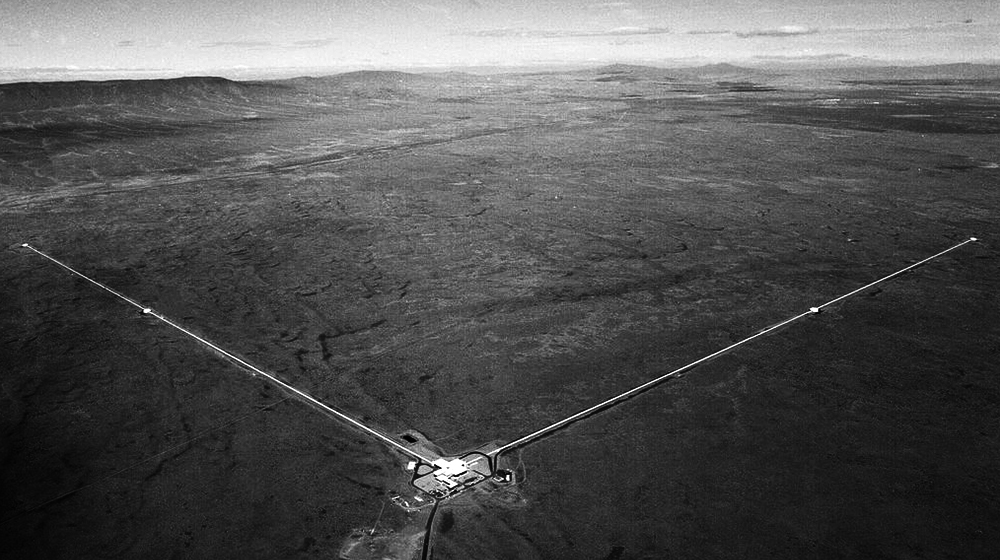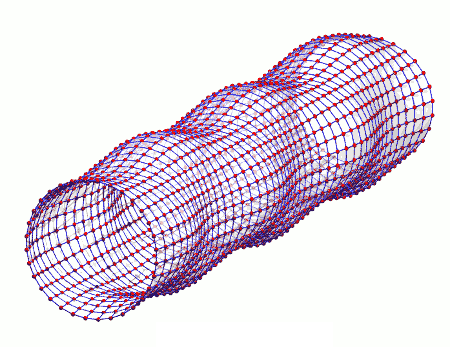Gravitational Waves Discovered at Long Last
Ripples in space-time have been detected a century after Einstein predicted them, launching a new era in astronomy.

As gravitational waves sweep past Earth, they alternately stretch and
compress the arms of Advanced LIGO’s twin detectors, located in Hanford,
Wash. (pictured), and Livingston, La.
Ripples in space-time caused by the violent mergers of black holes have been detected, 100 years after these “gravitational waves” were predicted by Albert Einstein’s theory of general relativity and half a century after physicists set out to look for them.
The landmark discovery was reported today by the Advanced Laser Interferometer Gravitational-Wave Observatory (Advanced LIGO) team, confirming months of rumors that have surrounded the group’s analysis of its first round of data. Astrophysicists say the detection of gravitational waves opens up a new window on the universe, revealing faraway events that can’t be seen by optical telescopes, but whose faint tremors can be felt, even heard, across the cosmos.
“We have detected gravitational waves. We did it!” announced David Reitze, executive director of the 1,000-member team, at a National Science Foundation press conference today in Washington, D.C.
Gravitational waves are perhaps the most elusive prediction of Einstein’s theory, one that he and his contemporaries debated for decades. According to his theory, space and time form a stretchy fabric that bends under heavy objects, and to feel gravity is to fall along the fabric’s curves. But can the “space-time” fabric ripple like the skin of a drum? Einstein flip-flopped, confused as to what his equations implied. But even steadfast believers assumed that, in any case, gravitational waves would be too weak to observe. They cascade outward from certain cataclysmic events, alternately stretching and squeezing space-time as they go. But by the time the waves reach Earth from these remote sources, they typically stretch and squeeze each mile of space by a minuscule fraction of the width of an atomic nucleus.
Perceiving the waves took patience and a delicate touch. Advanced LIGO bounced laser beams back and forth along the four-kilometer arms of two L-shaped detectors — one in Hanford, Wash., the other in Livingston, La. — looking for coincident expansions and contractions of their arms caused by gravitational waves as they passed. Using state-of-the-art stabilizers, vacuums and thousands of sensors, the scientists measured changes in the arms’ lengths as tiny as one thousandth the width of a proton. This sensitivity would have been unimaginable a century ago, and struck many as implausible in 1968, when Rainer Weiss of the Massachusetts Institute of Technology conceived the experiment that became LIGO.

Gravitational waves alternately stretch and squeeze space-time both vertically and horizontally as they propagate.
“The great wonder is they did finally pull it off; they managed to detect these little boogers!” said Daniel Kennefick, a theoretical physicist at the University of Arkansas and author of the 2007 book Traveling at the Speed of Thought: Einstein and the Quest for Gravitational Waves.
The detection ushers in a new era of gravitational-wave astronomy that is expected to deliver a better understanding of the formation, population and galactic role of black holes — super-dense balls of mass that curve space-time so steeply that even light cannot escape. When black holes spiral toward each other and merge, they emit a “chirp”: space-time ripples that grow higher in pitch and amplitude before abruptly ending. The chirps that LIGO can detect happen to fall in the audible range, although they are far too quiet to be heard by the unaided ear. You can re-create the sound by running your finger along a piano’s keys. “Start from the lowest note on the piano and go to middle C,” Weiss said. “That’s what we hear.”...MORE